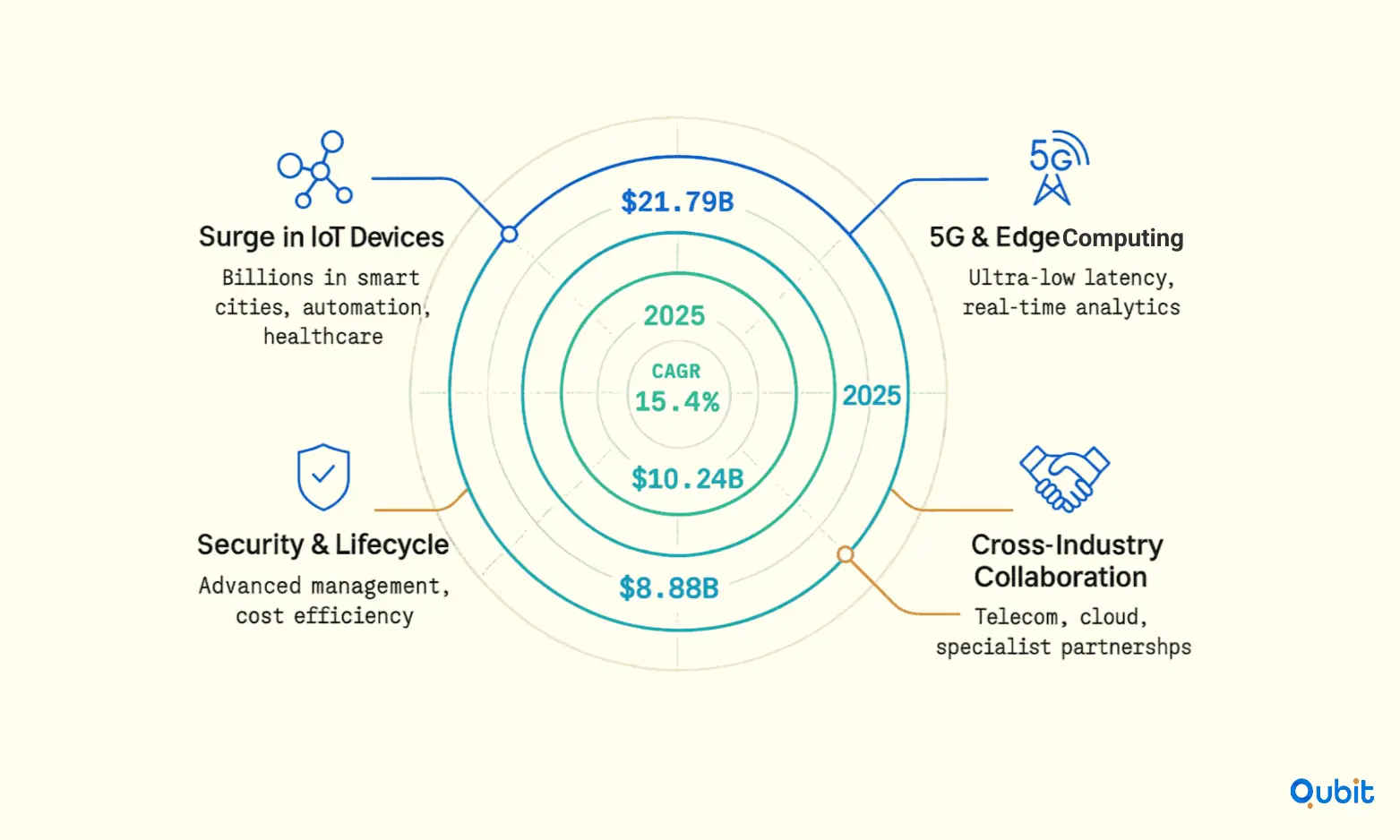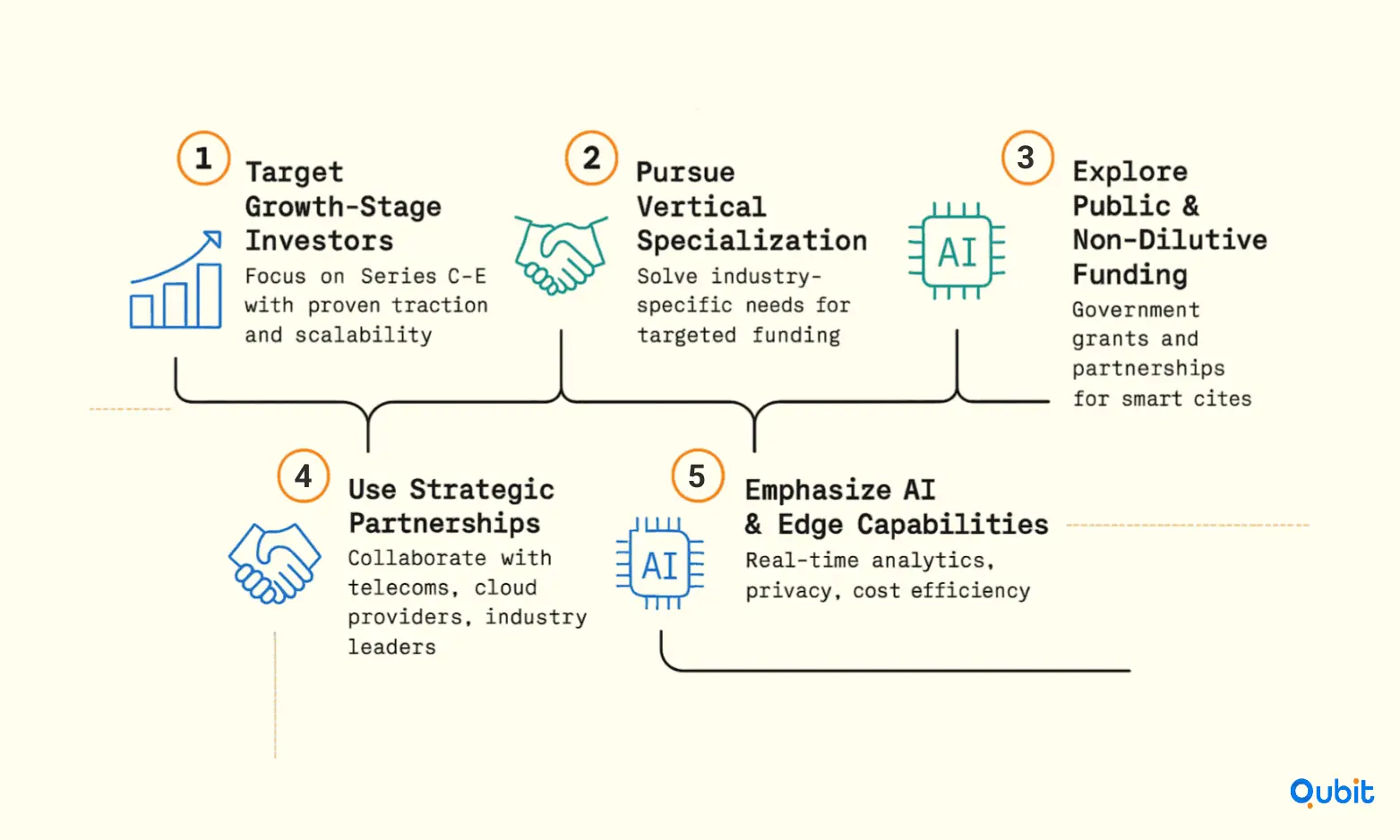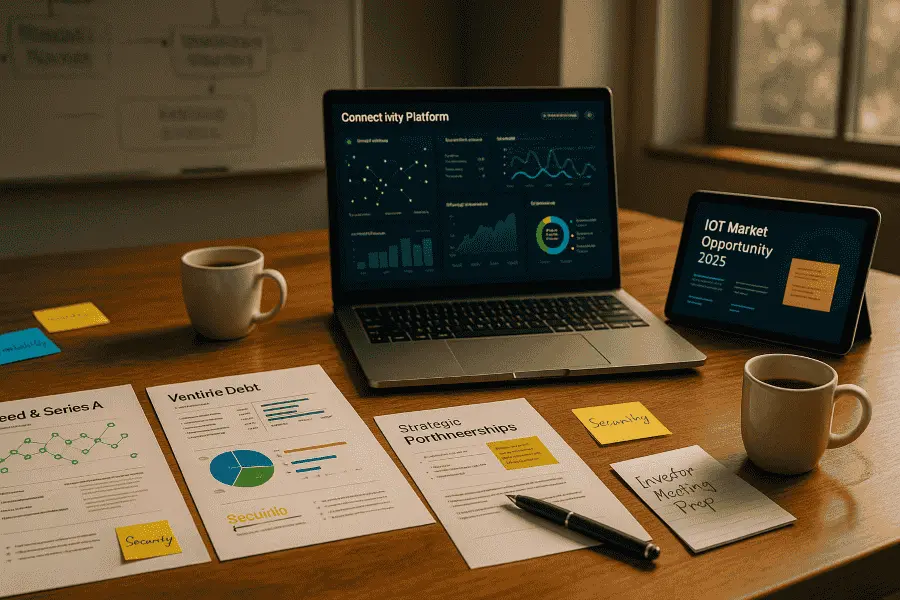The Internet of Things (IoT) revolution is reshaping industries, cities, and daily life. At the heart of this transformation are IoT connectivity platforms, software and infrastructure that enable billions of devices to communicate, share data, and deliver actionable insights in real time. As the world’s dependence on connected devices accelerates, so does the demand for robust, scalable, and secure connectivity solutions. This demand is fueling a dynamic funding landscape, with investors, corporates, and governments pouring unprecedented capital into the sector.
This article explores the current funding climate for IoT connectivity platforms, highlights the hottest trends, and provides actionable insights for founders and investors. We’ll also link to key resources on telecom startup funding, investment trends, and 5G/Open RAN opportunities for a comprehensive view of the market.
The IoT Connectivity Platform Market: Growth and Opportunity
The IoT connectivity management platform market is experiencing explosive growth. In 2024, the market was valued at $8.88 billion and is projected to reach $10.24 billion in 2025, marking a robust CAGR of 15.4%. By 2029, the market is expected to hit $21.79 billion, with a CAGR of 20.8%, driven by the proliferation of IoT devices, adoption of 5G, edge computing, and the increasing complexity of global IoT ecosystems.

Key Growth Drivers
- Surge in IoT Devices: The number of connected devices is soaring, with billions deployed across smart cities, industrial automation, healthcare, logistics, and more.
- 5G and Edge Computing: New network standards and edge architectures are enabling ultra-low latency, high-bandwidth, and real-time analytics at the device level.
- Security and Lifecycle Management: As IoT ecosystems grow, so do concerns over security, device lifecycle management, and cost efficiency, spurring demand for advanced connectivity platforms.
- Cross-Industry Collaboration: Partnerships between telecoms, cloud providers, and industry specialists are creating end-to-end IoT solutions and accelerating deployment.
The 2025 Funding Landscape: Record Momentum
Investment Volume and Trends
The IoT investment market reached new heights in 2024–2025, with over $1.45 billion flowing into specialized platforms and connectivity services. Growth-stage companies (Series C–E) captured 88% of total funding, signaling a mature market where investors back proven models and scalable platforms.
- Total Investment (2024–H1 2025): $1.457 billion across 16 major deals
- Average Deal Size: $91 million, reflecting a shift to larger, later-stage rounds
- Key Focus Areas: Industrial IoT and cybersecurity (34%), connectivity and satellite services (28%), smart city/building intelligence (22%), AI-driven analytics (16%)
Notable Recent Deals
| Company | Amount | Stage | Lead Investors | Business Focus |
|---|---|---|---|---|
| Terminus Technologies | $276M | Series D | Sequoia China, SoftBank | Smart city AI, traffic optimization, robotics |
| Armis Security | $200M | Series D | General Catalyst, Alkeon | Industrial IoT cybersecurity, asset intelligence |
| Platform Science | $125M | Series D | Prologis, NewRoad Capital | Fleet telematics, IoT logistics |
| TRACTIAN | $120M | Series C | Sapphire Ventures | Industrial monitoring, predictive maintenance |
| Fleet Space | $100M | Series D | Teachers’ Venture Growth | Space-based IoT, minerals exploration, defense |
| Butlr | $75M | Growth | Ricoh, Wistron | Privacy-preserving occupancy sensing, thermal AI |
| 1NCE | $60M | Growth | Deutsche Telekom, SoftBank | Global IoT SaaS, MVNO connectivity |
These mega-deals underscore the market’s shift from hardware-centric startups to software-driven analytics and connectivity platforms, with a strong emphasis on AI, security, and global coverage.
Who’s Investing? The New Power Players
Strategic Corporate Investors
Major telecoms, cloud giants, and industrial conglomerates are leading the charge. For example, Microsoft’s 10-year partnership with Vodafone integrates IoT connectivity with Microsoft’s cloud and analytics, while Deutsche Telekom and SoftBank are backing global SaaS platforms like 1NCE. These alliances combine network reach with AI and analytics to deliver seamless, scalable IoT solutions.
Venture Capital and Corporate Venture Arms
Venture capital is still active, particularly in areas like IoT security, edge analytics, and vertical-specific solutions (e.g., agtech, healthcare). Corporate venture arms (Samsung Next, Intel Capital, etc.) are investing to stay on the cutting edge and secure strategic advantages.
Public Sector and Infrastructure Investment
Governments are investing in IoT infrastructure through public-private partnerships and national testbeds. Examples include the Glasgow city IoT innovation hub (£2.5M public-private partnership) and national 5G/IoT testbeds in the US, EU, China, and the Middle East.
Market Maturity and Consolidation
The IoT connectivity platform market is maturing rapidly. Late-stage growth rounds dominate, and the average deal size has climbed sharply, reflecting investor confidence in platforms with real revenue and global reach. At the same time, the sector is seeing:
- Mergers & Acquisitions: Semtech’s $1.2 billion acquisition of Sierra Wireless and other major deals signal ongoing consolidation, as larger players seek to expand capabilities and market share.
- Platform Exits and Restructuring: Some early-stage or consumer-focused IoT startups have exited or pivoted due to competition and ROI challenges, but most promising companies are acquired by larger players rather than shuttered.
Key Funding Strategies for IoT Connectivity Startups

1. Target Growth-Stage Investors
With 88% of funding going to Series C–E rounds, startups should focus on building traction and revenue before seeking large rounds. Demonstrate market fit, scalability, and a clear path to profitability.
2. Use Strategic Partnerships
Partner with telecoms, cloud providers, and industry leaders to access networks, distribution, and co-investment. These alliances can accelerate product development, open new markets, and boost credibility.
3. Pursue Vertical Specialization
Investors are drawn to platforms that solve industry-specific problems—such as industrial IoT security, smart city infrastructure, or healthcare device management. Specialization can help differentiate your platform and attract targeted funding.
4. Emphasize AI and Edge Capabilities
AI-driven analytics, privacy-preserving sensing, and edge computing are top priorities for investors. Highlight your platform’s ability to deliver real-time insights, security, and cost efficiency at scale.
5. Explore Public and Non-Dilutive Funding
Government grants, innovation hubs, and public-private partnerships are injecting capital into IoT infrastructure and testbeds, especially for smart cities and national-scale deployments. Telecom startups often face unique funding hurdles, Secure Funding for Telecom Startups: Strategies and Insights walks through the real-world approaches founders have used to close their rounds.
Regional Insights: Where Is the Money Flowing?
North America & Asia-Pacific
These regions lead in both deal volume and size, driven by strong corporate investment, advanced telecom infrastructure, and robust startup ecosystems. China, the US, and Japan are home to several mega-rounds and strategic alliances.
Europe
Europe is seeing increased public-private investment, especially in smart city and industrial IoT projects. National testbeds and innovation hubs are fostering collaboration between startups, corporates, and governments.
Middle East & Emerging Markets
Countries like Saudi Arabia and the UAE are investing heavily in IoT infrastructure as part of broader smart city and digital transformation initiatives.
Trends Shaping the Next Wave of IoT Connectivity Funding
- 5G and Open RAN: The rollout of 5G and open radio access networks is unlocking new funding and partnership opportunities for IoT platforms. As connectivity shifts, investors are zeroing in on new opportunities, 5G & Open RAN: Investor Opportunities in 2025 lays out where the smart money is heading next.
- Cross-Industry Collaboration: Telecoms, cloud providers, and device manufacturers are joining forces to offer integrated, end-to-end IoT solutions.
- Security and Privacy: With rising cyber threats, platforms offering robust IoT security and privacy-preserving analytics are attracting premium valuations.
- Monetization and Billing: Investors are interested in platforms that enable flexible, usage-based billing and device lifecycle management—key for scaling in complex IoT ecosystems.
- Regulatory Changes: Evolving regulations on data privacy, device certification, and cross-border data flows are influencing investment priorities and platform design.
To understand what’s fueling deal-making right now, Top Telecom Trends Investors Are Watching in 2025. highlights the key developments shaping investor interest.
Challenges and Opportunities in IoT Sector
Challenges
- Complexity and Fragmentation: The IoT ecosystem is highly fragmented, with multiple standards, protocols, and device types complicating integration and scalability.
- Security Risks: The proliferation of connected devices increases the attack surface, making security and compliance top concerns for investors and customers.
- ROI and Monetization: Long sales cycles and uncertain ROI can slow adoption and make it harder for early-stage startups to attract funding.
- Market Consolidation: As the sector matures, competition intensifies, and only platforms with proven traction and differentiation will secure late-stage capital.
Opportunities
- Smart Cities and Infrastructure: Urbanization and government investment are driving demand for scalable IoT platforms in transportation, energy, and public safety.
- Industrial IoT: Predictive maintenance, asset tracking, and process automation are high-growth verticals attracting significant funding.
- Satellite and Global Connectivity: Space-based IoT and global SIM solutions are opening new markets and use cases, especially in remote or underserved regions.
- AI-Driven Analytics: Platforms that deliver actionable insights from massive device networks are commanding premium valuations.
Conclusion
The funding landscape for IoT connectivity platforms in 2025 is more dynamic and competitive than ever. With billions in capital flowing to growth-stage companies, the market is maturing rapidly, favoring platforms that deliver real-world value, security, and scalability. Strategic partnerships, regional investment hotspots, and the integration of AI, 5G, and edge computing are shaping the next wave of innovation and funding.
If you’re ready to explore hybrid funding strategies, Qubit Capital’s team can help you chart the best course for your vision and growth through it's fundraising assistance. Connect with us today!
Key Takeaways
- The IoT connectivity platform market is on track to surpass $10 billion in 2025, with a projected CAGR of 15–21% through 2029.
- Over $1.45 billion was invested in IoT connectivity platforms in 2024–2025, with growth-stage companies capturing the lion’s share.
- Strategic corporate investors, telecoms, and cloud giants are driving mega-rounds and shaping the future of IoT connectivity.
- Focus areas for funding include industrial IoT, cybersecurity, smart city infrastructure, and AI-driven analytics.
- Regional hotspots include North America, Asia-Pacific, and Europe, with rising investment in the Middle East and emerging markets.
- Success depends on traction, vertical specialization, strategic partnerships, and the ability to address security, scalability, and monetization challenges.
Frequently asked Questions
What is an IoT connectivity platform?
An IoT connectivity platform is software and infrastructure that enables devices to connect, communicate, and manage data across networks, supporting device onboarding, security, analytics, and lifecycle management.


 Back
Back



